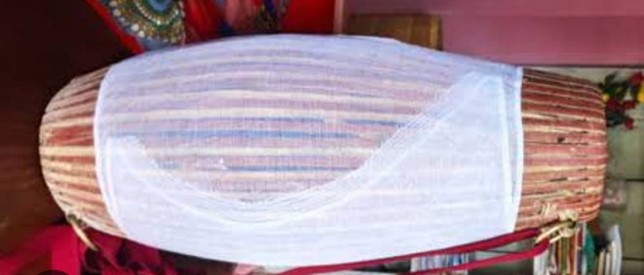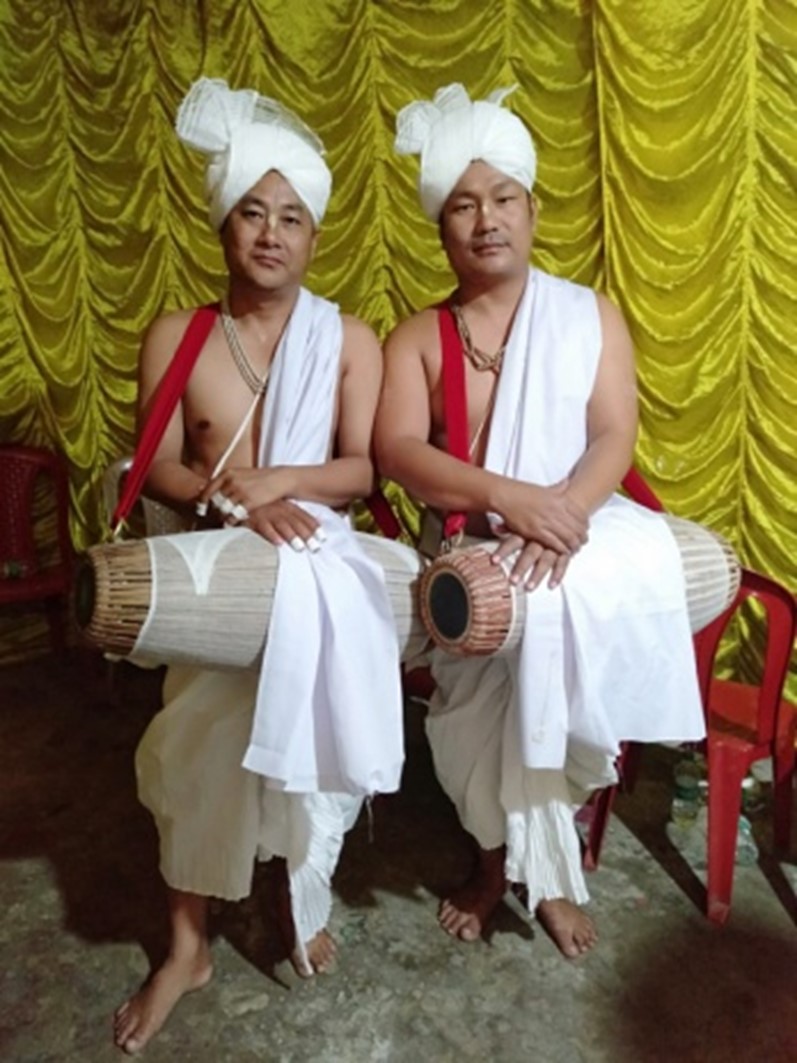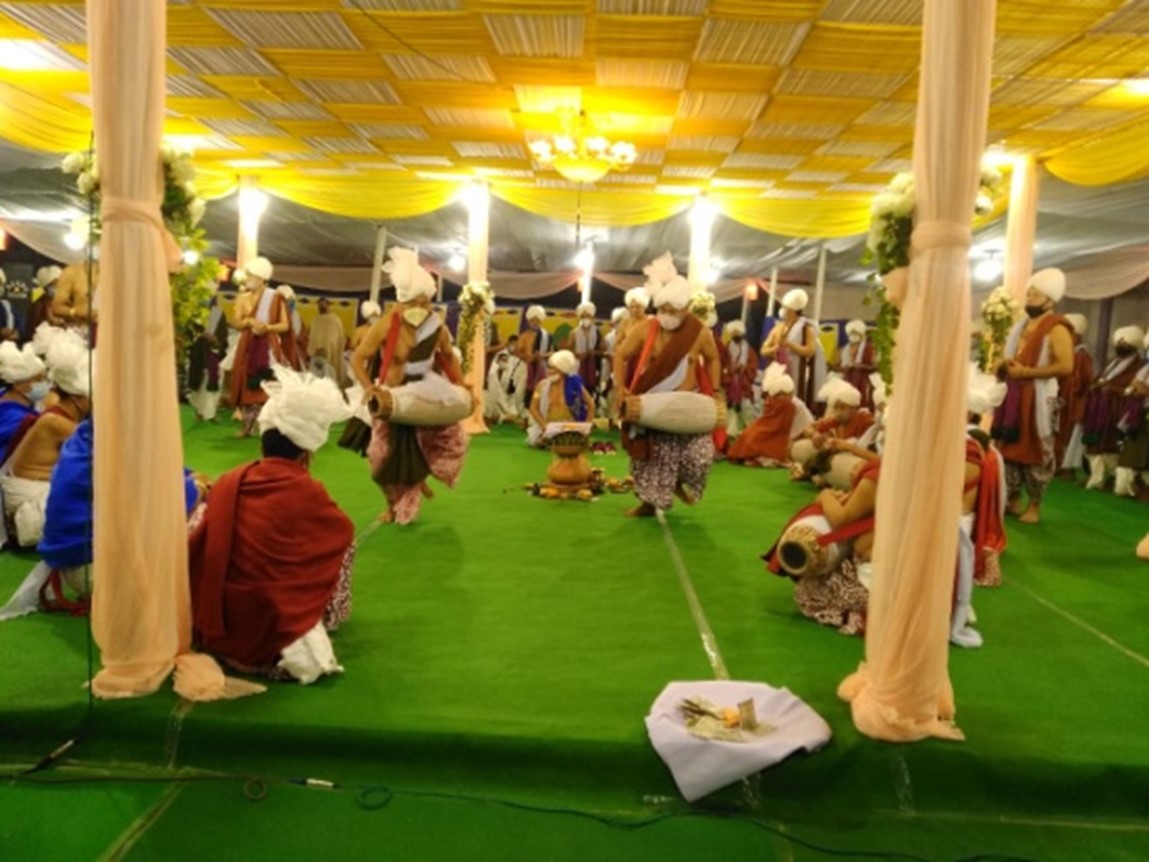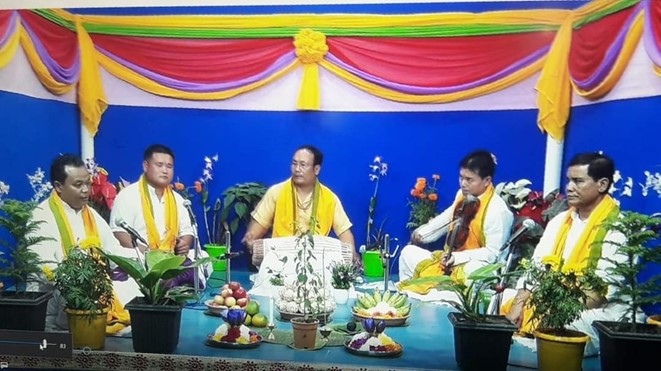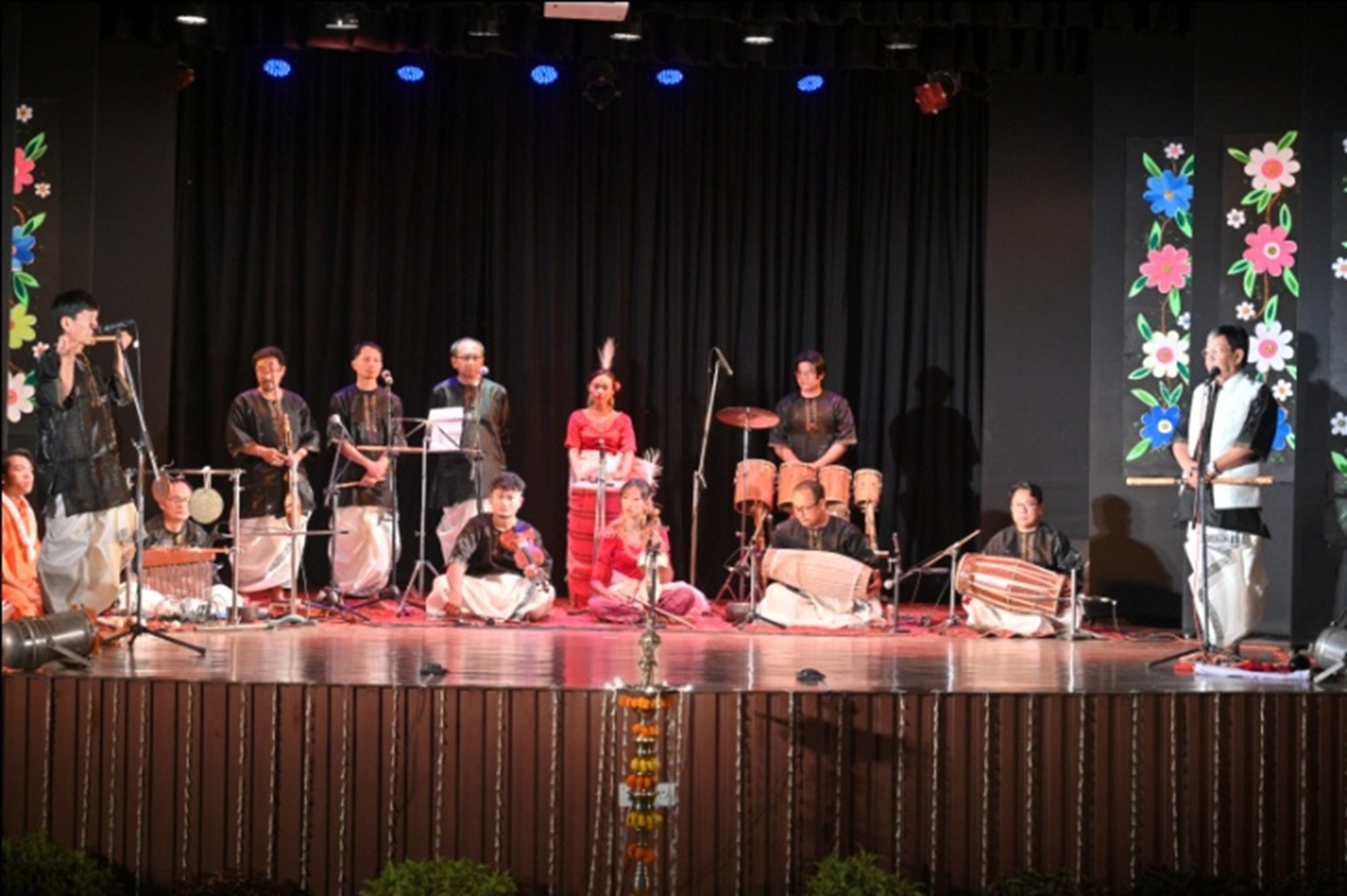Changing Trends of Meitei Pung
- Lukram Tamphamani Singh
- 1155-1162
- Aug 22, 2024
- Cultural Studies
Changing Trends of Meitei Pung
Lukram Tamphamani Singh
Research Scholar Visva Bharati University,
Shantiniketan, West Bengal, India
DOI: https://doi.org/10.51244/IJRSI.2024.1107091
Received: 06 July 2024; Revised: 20 July 2024; Accepted: 24 July 2024; Published: 22 August 2024
INTRODUCTION
In many culturally related traditional programs and customs of Manipur, Meitei Pung has taken a very important role since its inception. The changing facets in Meitei Pung have also played a very prominent role in the transforming Manipuri Culture. It has always been an area of interest to study the various elements that contributes in the perpetual change of culture that gives shape to the existence of a society in particular and a nation at large. Time and again, it has been expressed and agreed to, that culture holds a strong position in nurturing a strong foundation for a society, but nevertheless it experience a slow pace in the developmental process. But before delving into anything, it is primarily important to discuss on what actually constitutes a cultural change.
A culture is the outcome of collective efforts of groups of people, their ideas, customs and social behaviors that is accepted at large by the society eventually, what has been constructed over a period of time. It cannot be visualized for a definite purpose. Its making is gradual and perpetual, that goes hand in hand with the transitions in a society. Culture is the mixture of human knowledge, believes, behaviors and traditional values which are recognized and accepted by the society. Dr. S. Radhakrishnan expressed that habits form customs and eventually the customs becomes tradition after its prolonged usage which finally is accepted as the culture of a society. People who were elemental in shaping the culture of a society make it their priority to safeguard the cultural values and not make it susceptible to deterioration. It is therefore essential to take into account and discuss in detail the various elements that contributed in the cultural transitions of the society.
OBJECTIVES
The following are the objectives of the study:
1. To find out the level of change of Meitei Pung in Manipuri society.
2. To find out the changes from old traditional forms to new trends
METHODOLOGY
For the study, practical descriptive method of research has been adopted to explore and describe the characteristics, status of change and the path treaded by the society in embracing the change.
TRENDS OF TRANSITION / TRANSFORMATION IN MEITEI PUNG
Fig.1: Meitei Pung
Just like what Dhyaana did for Satya Yuga, Yagna for Dretwa Yuga and Puja for Dwapur Yuga, to pave way for attaining Moksha (Salvation) for people of that Yugas, similarly in Kali Yuga embodying different facets of Dhyana, Yagna and Puja clubbed into one form generally accepted to be a Mahayagna, “Harisankirtana” is claimed to be the way of attaining Moksha (Salvation) for people of Kaliyuga. Hence, it is believed to be the best of the four Yugas and therefore called as “Dhanyakali”.
In the composite version of rhythm, song and dance, exemplified by Music (Sangeet) in its supreme form, “Nata Sankritana” which is complete in its own sense, “Meitei Pung” serves as the Prime and Supreme element when defining “Nata Sankirtana” is concerned. The Invocation is always done by Meitei Pung to mark the starting of any ritual observances that comes under Nata Sankirtana. It is noteworthy that the duration of the composite music comprising of song, dance and rhythm is decided by the Rhythm (Taal), hence “Taal” is referred to as the Soul of Music. And to this composite music, the instrument that gives life to the rhythm is the “Pung”. To be precise, in Manipur Nata Sankirtana, as per the beats and rhythm produced by Pung, songs are sung by the artists, dance according to the beats and display Choloms. Consequently, the Gurus of this performing art opined and taught accordingly that Pung plays the most instrumental part and holds a prime position in this composite music.
Fig. 2: Author (second from left) posing before Performance
All the musical instruments that have its existence and association with music in the world have their own style and method of producing musical sounds. Out of these, Meitei Pung has all the more distinctive features and versatile style comparatively with other musical instruments, which has to be researched more and studied minutely to manifest more of the versatility that “Meitei Pung” can display. Of the vast area which can be discussed at length, if one topic is picked up, there is one big question mark on the current condition of “Meitei Pung” which existence has come under the scanner. Not only does it holds an undeniable significance in Manipuri Society, it has also brought Manipur to the light in the field of Arts and Culture, but does anyone care about the existing condition in which the artists associated with playing Meitei Pung is striving the sustain the quality performance usually expected from them. Just researching systematically about the difference in the condition of Meitei Pung, in its yesteryears and in the current scenario will give a briefed up inference about the characteristics the Meitei Pung possesses and what future lies ahead of it.
Before the 18th century and just from the advent of this century, even if the existence of different types of Sankirtana being practiced could be trailed, however it is believed that in 1779, on the 11th day of Hiyangei (that falls in November usually) which fell on Friday, the day of the coronation of Shri Shri Govindajee marked the beginning of a new transformed “Nata Sankirtana”. And from then continued to display its strong existence. As a result of which, comparing the journey treaded by Meitei Pung and Nata Sankirtana to have evolved in the current form it is now, will not be a miscalculation. Not to omit the fact here is, “Manipur Rasa Lila” one of the major Indian Classical Dance forms which enjoys international acclaim owing to its exquisite performances , costumes and dance movements, had its first performance on this very day, and therefore its journey will be termed as incomplete when its journey is studied devoid of Meitei Pung. If the journey of Pung and thevarious twists and turns that it has experienced aretaken into consideration, just taking into account the later half of the 18th century would suffice for the various changes that “Pung” has endured for long. To cut it short, the reason being in “Sankirtana”, the practical features when discussed remains more or less the same. Hence, it would be a wiser decision to discuss in detail the sounds produced by Pung and the languages associated with it used by the “Ariba Pala” and “Nata Pala” in Sankirtana. Because it is an obvious and unquestionable fact that this art form must have gone through various experimentations, improvisations after exploration of numerous physical resources for Ariba Pala to have evolved into the new Sankirtana form.
MAIN FINDINGS
Interestingly after the inception of “Nata Sankitana”, as a part of it, the association of Manipur Rasa Lila with Meitei Pung and the contribution Meitei Pung renders to various ritual and non-ritual performances, the transition or transformation or to be precise, the improvisations it underwent and why it evolved taking the test of time, can be briefly categorized into the following:
- The changing trends in Sankirtana.
- The changing style in playing Pung in performances of Manipuri Rasa Lila.
- The changing features of Meitei Pung when being played as a Classical folk or in Light Musical forms.
The Changing Trends in Sankirtana
Fig. 3: Meitei Pung in Mahadhumen Sankirtana
Since the earlier times, in Manipur, in various forms of Sankirtana, viz. Naam Kirtana (chanting and singing the name of God), Guna Kirtana (Singing and praising the mighty power of the Lord) and Lila Kirtana (enacting the role of Deities, the creator or the supreme being), performing Kirtana with atleast a Pung accompanied by a song was generally accepted in yesteryears and continue to retain this tradition till now. Kirtana was being offered right from a person’s birth to his death, in all the Dash Karmas of a human’s existence in the material world and in other occasions as well. But with changing generation and human mentality accordingly, importance of Sankirtana seemed to subside eventually resulting to Kirtana being engaged only on occasions considered unavoidable. If given a thought, it can be said that the probable and most accurate answer to this will be that humans tend to forget there is a supreme power who is the master of all creations and take up whatever path they wish to tread upon. Just as humans face the wrath of global warming, likewise human souls after meeting their death will not find ultimate salvation (Moksha) in the path to unite with the supreme power, God! Men never bothered when being alive as God’s judgments seemed to arrive a little delayed than needed. Hence, in the journey of Nata Sankirtana, creating a huge impact in the way Sankirtana was being performed, the changes eventually giving an impact on Manipuri Culture.
Fig. 4: Nata Sankirtana Ritual Performance
On the other hand, since olden times, the Gurus of Pung gave their heart and soul on this instrument to showcase its beauty. The dedication they had at that time is invisible in people of this generation. It won’t sound misjudged or misinterpreted to say that the interest vested on this particular instrument is minimal and totally changed. Earlier the disciples used to stay at the teacher’s place and learn the art till their heart’s content and aiming for perfection. But with changing times and development of technology, now people learn this art at various institutes and through various other devices like sound recordings, substituting the actual Gurus, accumulating short lived knowledge in the process. Though technology advancement has positive sides to learning this art, people who got accustomed to learning through this method will surely lack the deeply rooted systematic learning a pupil attains by learning under the Guru-Kul system, the discipline is what the former have advantages over the latter. However advanced technology be, the advantage of learning directly under a Guru and gathering the knowledge of singing and speaking drum synced together, exhibited by the expert and the experienced will always be missed out definitely. Due to all these reasons, all the flawless beating of the drums accompanied by absolute Choloms, the secret to such flawless performances got carried away along with the Gurus when they left the earth for heavenly abode. And from the Gurus who were still alive, pupils failed to accumulate knowledge and ineffectively learned from the expertise that the Gurus possessed with them. As a result of which Meitei Pung is believed to have suffered undesirable improvisations.
The Changing Style in playing Pung in performances of Manipuri Rasa Lila
“Manipuri Rasa Lila” traces its existence back at the time when only three or four forms were recognized as Classical Dances of India. The dance performances have earlier been exhibited as an offering to please the Almighty, which were mainly performed at Shri Shri Govindajee Temple and Mandapas. The transition phase when “Manipuri Rasa Lila” began to be performed on stage has been recorded during the reign of King Churachand (1892-1941). The journey of this performing art to have set its foot on proscenium stage is believed to have started as early as 1930 when King Churachand Singh sent a cultural troupe to Calcutta (now Kolkata) led by the Great Guru Amubi Singh to perform Rasa Lila. During the period when in 1779, the first performance of Rasa Lila was offered to please the God till 1930, the pioneer, the Gurus who led “Manipuri Rasa Lila” had thorough knowledge with in depth details about Meitei Pung. Till the first 2 decades of the 21st century, people who were given the respect of being the Great, knowledgeable in Rasa Lila, The Rasdhari played pung irrespective of the changes it had gone through. But many out of them failed to acquire the essential theoretical and practical knowledge of playing pung as they gave dance more weightage over Pung. Hence, as a part of “Manipuri Rasa Lila”, in addition to the changes in the performances in Pung at Mandapa, several changes in stage performances were also starkly visible. The people responsible for musical composition of the Manipuri Rasa added many new instruments which were earlier definitely not a part of the orchestra. As a consequence, there were many instances where there were problems in controlling the level of the song and sound the musical instruments produced, mismatch of the scale made Pung suffer the pain of adjusting to the unsolicited changes. Adjustments to the different scales produced some noteworthy beautiful sounds while on the other hand some of the real beauties of Meitei Pung disappeared which is a very disappointing fact. These are also one of the changes in the life history of Meitei Pung.
The Changing Features of Meitei Pung when being played as a Classical, Folk or in Light Musical Forms
When a resulting change of a particular element takes certain and distinct role in its journey, at this point is where controversy lies when distinguishing that a certain musical form or instrument shall be categorized under classical or folk. On the other hand, without really describing the changes it had undergone, the changes itself give them a feasible interpretation it actually deserved. It is quoted that “Music has no language”. In musical interpretation, the classifications viz. Classic, Tradition, Light or Folk neither have any relevance with the musical form nor with the “Presentation Style” and the “Composition”.
Fig. 5: On Stage with Classical Instruments
Fig. 6: Meitei Pung with Other Musical Instruments in Creative Music
Meitei Pung having its roots and being a part of various performances in the likes of “Nata Sankirtana”, “Maha Sankirtana”, “Dhoomen”, “Raasa” etc, it will be appropriate to discuss how far Meitei Pung can undergo variations let alone it be classified as Traditional or Classical. It will also be an interesting facet of Meitei Pung to learn the different variations in sound it is capable of producing when played with different musical instruments and other musical forms. Here, it will be wise to remember the famous saying, “Mixing things is always a beauty!” According to Swami Vivekananda, a creation is hardly possible unless two entities are mixed up. It is always expected to result a better form with the intermixing of two cultures, when the elements inspired from some other culture absorbs into their own soil post the amalgamation with the cultural aesthetics of the society. It is most likely that multicultural outcome may result into more innovative and colorful production. It is visibly transparent in the recent developments Meitei Pung has manifested while it undergo the process of mix and match with other musical forms of the world, though it is still in a novice stage. If we take an example, Meitei Pung which earlier used to be played along with Kartaal, Jhaal and Maangang only, later on started to be played along with instruments like Taar Shehnai (Israaj) and flute etc. in performances of “Manipuri Raasa”. One can note the strong influence it has on the other instruments, that it not only coherently plays along with the other instruments, the other instruments on the contrary behave like they were already a part of Manipuri culture from very early on.
Fig. 7: Devi Dhumel performance of 14 Drummer
After Manipuri Raasa began to be performed on stage, introduction of Violin, Sitaar and other instruments resulted into more innovative and beautiful compositions altogether. Also, Meitei Pung possesses all the essential musical criteria that it is supposed to have for it to be classified as a Classical Instrument, rightly exemplified by Manipuri Classical solo dance (which is a Classical Dance) in which Meitei Pung plays a prominent role in the musical composition. Such type of solo dance and other rhythmic movements are based on the beats of the Meitei Pung. In current times, the biggest developmental change we can see are the composers, accompanists and singers working in popular music, like those in Manipuri Film Industry and light music appreciating Meitei Pung after realizing the wonders it can do. These people make it their habit to include Meitei Pung in the orchestra for every new composition they produce. The versatility possessed by Meitei Pung makes it capable of don any role that it is given and always succeed in resulting into a satisfactory outcome. But as everything has its positive and negative sides, sometimes the beauty for which Meitei Pung is known for, tend to lose in its quest for adjusting itself to satisfy the levelling of the scale of the composer’s production. Here, one point to be noted is, we should be well aware of the keys, notes or scale of Hindustani or Western Music, where the best and original sound of Meitei Pung can be synced exactly with them. For those scales to be perfectly matched, it very well depends on the diameter of the Manao (right side of the beating surface), the sharpness of the central area of the drum’s beating area (Gaab), its thickness or the way the tuning paste is polished for better performance should be well discussed.
What the Pung yeiba (Drumers) should keep in mind is that they should be knowledgeable about Hindustani, Western and Manipuri music well enough. In brief, in a single Taal of which people normally have knowledge about, one should be aware that the “Manipuri Tanchap” has ‘Kaharwaa’ as its description in Hindustani while Western interprets it as 1/4th in its musical notes. Likewise, the scales which are used very often, should be well memorized and till the extent it is possible for knowledge to be accumulated, there should be no hesitation to learn it. But having said that, the latest position Meitei Pung has been capable of holding on in popular music, is a clear example of the biggest and recent developmental change it has managed to achieve.
CONCLUSION AND SUGGESTION
Since early times, Meitei Pung has and continued to play a prominent part in Manipuri Culture. But in the olden times, people never bothered to give in real and serious attention to the changing cultural trends, when society tried to follow the changing world. However, people could hardly avoid the changing culture, even if the society were aware of the changes or not. The changes that Meitei Pung has endured to be in sync with the changing Manipuri Society is indeed a matter to take pride of as Meitei Pung can be considered as the backbone of Manipuri Society. Therefore, it is high time to discuss in detail the traditions, regrading trends and the latest changes in recent times of Meitei Pung, so that a conclusion could be attained to lay down the do’s and don’ts, conservative and progressive factors may be pointed out to encourage and nurture for better evolvement of Meitei Pung however a late step it may seem, as a result of which the wonders Meitei Pung is capable of showing to the whole world do not remain hidden and die a silent death.
At this juncture, one important question arises and that is till when this vulnerability can be avoided? As it is a well discussed and accepted fact that, “Change is the only constant”. Everything in the universe is subject to gradual change or swift change. Hence,
- Manipuri Society and its culture cannot be kept aloof from the inevitable, nevertheless the merits and demerits of the changes associated depends largely on the direction of the change and the path treaded by the society in embracing the change.
- It is very much the need of the hour to sustain the high quality and power packed performances Meitei Pung deserves to be given accolades for and showcase to the whole world, the beauty it is blessed with.
REFERENCES
- Singh, Ch. Manihar. 1996: A History of Manipuri Literature. Sahitya Akademi, New Delhi.
- Nilakanta, Elangbam. 1971: Manipuri Dance Seminar. Manipur State Kala Akademi.
- Ayekpam, Rajmani. May 31, 2017. The Cosmic Mirror: Souvenir, Volume-1, Progressive Artiste Laboratory.
- Singh, M. Thoiba. November 28, 2014: Facets of Manipuri Culture.
- Sharma, Laimayum Devendrajit. July 1988: Sangeet Prakaash.
- Singh, Guru Shree Khangenbam Gulapi. July 1973: Shree Shree Gour Gobinda Thouram Sheireng.
- 1986: Historical and Cultural Relations Between Manipuri, Assam and Bengal. Manipuri Sahitya Parishad, Imphal.
- Singh, Thokchom Ibohal. January 2009: Shree Shree Gobindagi Ashthkaal.

